“ Philippines Weather Awareness Animates Travel “
“Knowing The Dynamics Of Wet Or Dry Season Has More Tidings
If You Choose It”
Understanding Philippines weather can meet your simple-to-elegant travel measures. Its dynamics of wet or dry season has more tidings if you choose it… wherever you are in Luzon, Visayas or Mindanao.
The Philippines weather system submits to the global body of knowledge on weather. It has its own Filipino character though, but it does not digress from the global standards.
Philippines history would show that Filipinos in older generations simply interpreted weather by the twin terms of Amihan and Habagat. They knew the seasonal shifts by just marking wind direction.
When the prevailing winds come from the east, they called it Amihan. When winds emanate from the west, they called it Habagat.
The Amihan(northeast monsoon) occurs in November-April… it’s the dry season for the most part. It’s the tourist season.
The Habagat(southwest monsoon) occurs in May-October… it’s the wet season for the most part. It’s the typhoon season.
Understanding Amihan or Habagat can help you decide to see, live or invest in the Philippines.
More Thoughts You Can Dig
PAGASA… The Weather Authority
The country’s official weather authority is called PAGASA. It’s an acronym for Philippine Atmospheric, Geophysical and Astronomical Services Philippines. It monitors and manages weather pronouncements in the Philippines.
Philippines Weather Forecast
PAGASA assumes weather forecasting in the Philippines. It has its hands full in these critical areas of considerations…
- 24-Hour Public Daily Weather Forecast
- Airways and Terminal Forecast
- Forecast for Philippine Cities and Municipalities
- Forecast for Selected Asian Cities
- 24- Hour Shipping Forecast
PAGASA updates data and information about current weather Philippines.
Philippines Climate
The Philippines’ climate has 2 seasons… wet and dry, or Amihan and Habagat. It’s rainy in June-November. It’s dry in December-May. It’s cool and dry during October-February. And it’s hot in March-May with Flores de Mayo at hand.
You can draw the most advantages of seeing, residing or doing business in the country during the dry months.
The country's annual average temperature is 26.6°C. Humidity hovers at 71-85%. The coolest month is January with 25.5°C temperature… warmest is May at 28.3°Celsius.
Highland areas are cooler than the lowlands. Eastern Philippines experience year-round rainfall.
There are 21-23 typhoons that hit country each year. Most typhoons come from the Eastern Pacific… a few from the China sea.
Here’s a simple climate map re Philippines weather…
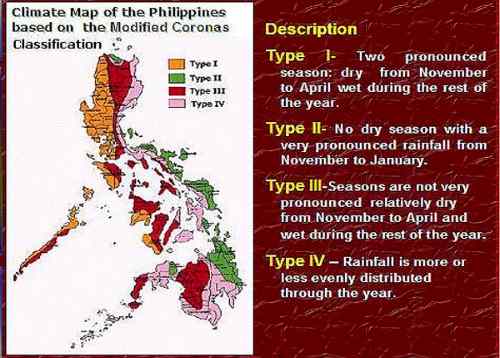
Philippines Weather Seasons
December-May – This interval is hot… it’s the dry season. There are occasional showers in the afternoons which people love. The March-May period is the hottest… the best time to go to beaches and water resorts. You can best see the country side on this period.
The prevailing wind in this period is the Amihan, which comes from the east. The Amihan is a favorite female character in stories portraying the Filipino culture.
June-November - This period is rainy… it’s the wet season, it’s the typhoon regime. During this period, an average of 21 typhoons hit the country. A few times, it reaches 23. Typhoons in November are much less and when they come… they are really ugly and very destructive.
The prevailing wind in this period is the Habagat, which comes from the west.
Here’s a simple typhoon map re Philippines weather…
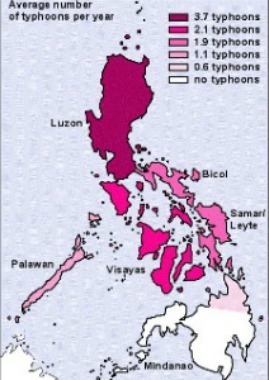
Philippines Weather Conditions
High temperature and high humidity are signatures of Philippine weather. It’s cool and dry in December-February… part of the dry semester.
You can visualize the rainfall and prevailing temperature of the Philippines each year by this plain Philippines weather chart…
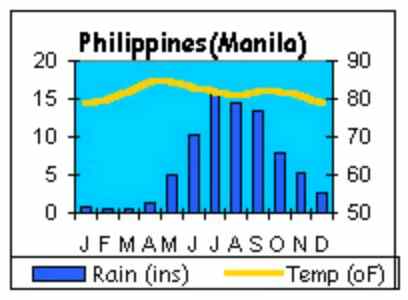
The eastern part of the country is the most rain-soaked year round. The rains there are heavy, frequent and longer.
Here’s the usual consequence of Philippines weather, an ugly Flood in Manila…
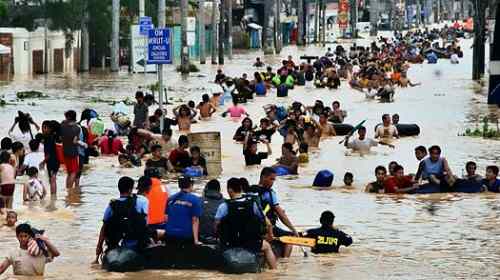
Here’s another one, the ugly flash flood aftermath in Cagayan de Oro City…
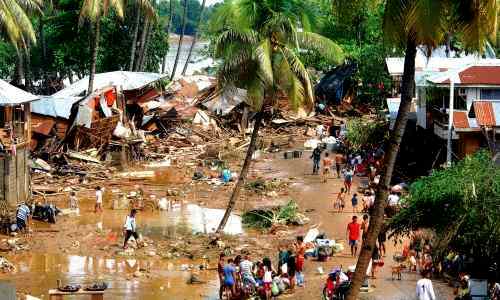
Philippines Weather Report
Weather reporting in the country is much more active during the rainy season than in the dry spell. Information that weather bureaus disseminate comes from different sources, like…
- Radar systems
- Weather balloons
- Land-based observation stations
- Weather buoys
- Airplanes and ships
- Satellites
PAGASA is the country’s official weather authority. From them, Philippine media obtain weather bulletins that eventually reach the populace.
For the internet users, online reports are all there for grabs.
In closing…
Understanding Philippines weather can meet your simple-to-elegant travel measures. Its dynamics of wet or dry season has more tidings if you choose it wherever you are in Luzon, Visayas or Mindanao.
Keeping tabs of the weather can make your stay in the Philippines a more enjoyable one. And…
Grasping Amihan or Habagat can help you decide to see, live or invest in the Philippines.
Back to top of this page
Return from Philippines Weather page to Philippine Islands page
Return from Philippines Weather page to Top Destination Choice The Philippines Home Page